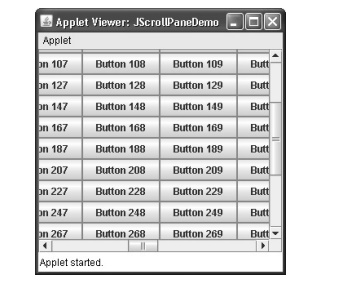Chapter: Java The Complete Reference : Introducing GUI Programming with Swing : Exploring Swing
JScrollPane - Swing
JScrollPane
JScrollPane is a lightweight container that automatically handles the scrolling
of another component. The component
being scrolled can be either an individual component, such as a table, or a
group of components contained within another lightweight container, such as a JPanel. In either case, if the object
being scrolled is larger than the viewable area, horizontal and/or vertical scroll bars are automatically provided, and the
component can be scrolled through the pane. Because JScrollPane automates scrolling, it usually eliminates the need to
manage individual scroll bars.
The viewable area of a scroll
pane is called the viewport. It is a
window in which the component being scrolled is displayed. Thus, the viewport
displays the visible portion of the component being scrolled. The scroll bars
scroll the component through the viewport. In its default behavior, a JScrollPane will dynamically add or
remove a scroll bar as needed. For example, if the component is taller than the
viewport, a vertical scroll bar is added. If the component will completely fit
within the viewport, the scroll bars are removed.
JScrollPane defines several constructors. The one used in this chapter is shown
here: JScrollPane(Component comp)
The component to be scrolled
is specified by comp. Scroll bars are
automatically displayed when the content of the pane exceeds the dimensions of
the viewport.
Here are the steps to follow
to use a scroll pane:
Create the component to be scrolled.
Create an instance of JScrollPane,
passing to it the object to scroll.
Add the scroll pane to the content pane.
The following example
illustrates a scroll pane. First, a JPanel
object is created, and 400 buttons are added to it, arranged into 20 columns.
This panel is then added to a scroll pane, and the scroll pane is added to the
content pane. Because the panel is larger than the viewport, vertical and
horizontal scroll bars appear automatically. You can use the scroll bars to
scroll the buttons into view.
// Demonstrate JScrollPane.
import java.awt.*;
import javax.swing.*; /*
<applet code="JScrollPaneDemo"
width=300 height=250> </applet>
*/
public class JScrollPaneDemo extends JApplet {
public void init() { try {
SwingUtilities.invokeAndWait(
new Runnable() {
public void run() {
makeGUI();
}
}
);
} catch (Exception exc) {
System.out.println("Can't create because
of " + exc);
}
}
private void makeGUI() {
// Add 400 buttons to a panel.
JPanel jp = new JPanel(); jp.setLayout(new
GridLayout(20, 20));
int b = 0;
for(int i = 0; i < 20; i++) { for(int j = 0;
j < 20; j++) {
jp.add(new JButton("Button " + b));
++b;
}
}
//Create the scroll pane.
JScrollPane jsp = new JScrollPane(jp);
//Add the scroll pane to the content pane.
//Because the default border layout is used,
//the scroll pane will be added to the center.
add(jsp, BorderLayout.CENTER);
}
}
Output from the scroll pane
example is shown here:

Related Topics